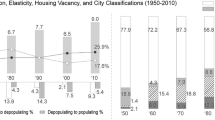Abstract
Brueckner et al. (Econ Rev 43:91–107, 1999) remark that city’s historical amenities, which are considered exogenous today, may have been formed endogenously over time. This paper develops a simple two-period model based on this idea. It assumes there are two locations in a city and two income types. Lot sizes are decided myopically in the first period and cannot be adjusted later. Without historical amenities, locations of the rich and the poor are never reversed (the poor always locate closer to the center) for increasing population, income and utility levels of each type. If the rich leave some “historical amenity” behind for the residents in the second period, locations are reversed when the population of the first period is moderate, income disparity between the two types is low and the rich is sensitive to amenity.
Similar content being viewed by others
References
Akita T, Fujita M (1982) Spatial development processes with renewal in a growing city. Environ Plan A 14:205–223
Alonso W (1964) Location and land use. Harvard University Press, Cambridge
Anas A (1978) Dynamics of urban residential growth. J Urban Econ 5:66–87
de Bartolomé CAM, Ross SL (2003) Equilibria with local governments and commuting: income sorting vs income mixing. J. Urban Econ 54:1–20
Breffle WS, Morey RE, Lodder TS (1998) Using contingent valuation to estimate a neighborhood’s willingness to pay to preserve undeveloped urban land. Urban Stud 35:715–727
Bergstrom TC, Goodman RP (1973) Private demands for public goods. Am Econ Rev 63:280–296
Brueckner JK (1980) A vintage model of urban growth. J Urban Econ 8:389–402
Brueckner JK, Thisse J-F, Zenou Y (1999) Why is central paris rich and downtown detroit poor? An amenity based theory. Euro Econ Rev 43:91–107
Epple D, Sieg H (1999) Estimating equilibrium models of local jurisdictions. J Polit Econ 107:645–681
Fujita M (1982) Spatial patterns of residential development. J Urban Econ 12:22–52
Harrison D Jr, Kain JF (1974) Cumulative urban growth and urban density functions. J Urban Econ 1:61–98
Henderson VJ (1985) Economic theory and the cities (Section 3.1.) Academic, New York
Mills ES (1967) An aggregative model of resource allocation in a metropolitan area. Am Econ Rev 57: 197–210
Muth RF (1969) Cities and housing. University of Chicago Press, Chicago
Muth RF (1971) The derived demand for urban residential land. Urban Stud 8:243–254
Navrud S, Ready RC (2002) Valuing cultural heritage: applying environmental valuation techniques to historic buildings, monuments and artifacts. Edward Elgar, Cheltenham
Rise-Ackerman S (1975) Racism and urban structure. J Urban Econ 2:85–103
Sasaki K, Mun S (1996) A dynamic analysis of multiple-center formation in a city. J Urban Econ 40:257–278
Sweeney JL (1974) A commodity hierarchy model of the rental housing market. J Urban Econ 1:288–323
Tiebout CM (1956) A pure theory of local expenditures. J Polit Econ 64:416–424
Wheaton WC (1977) In come and residence: an analysis of consumer demand for location. Am Econ Rev 67:620–631
Wheaton WC (1982) Urban residential growth under perfect foresight. J Urban Econ 12:1–76
Yonemoto K (2006) A vintage spatial model where history has value. PhD dissertation, University of Colorado, Colorado
Author information
Authors and Affiliations
Corresponding author
Additional information
An earlier version of this paper was presented at International Symposium on Spatial Economics and Transportation, Sendai, Japan, June 13, 2005. The paper has benefited greatly from the comments of Dr. Jan Brueckner, who participated in the symposium, and Dr. Charles de Bartolomé, my academic adviser in the University of Colorado at Boulder.
Rights and permissions
About this article
Cite this article
Yonemoto, K. Endogenous determination of historical amenities and the residential location choice. Ann Reg Sci 41, 967–993 (2007). https://doi.org/10.1007/s00168-007-0128-4
Received:
Accepted:
Published:
Issue Date:
DOI: https://doi.org/10.1007/s00168-007-0128-4




